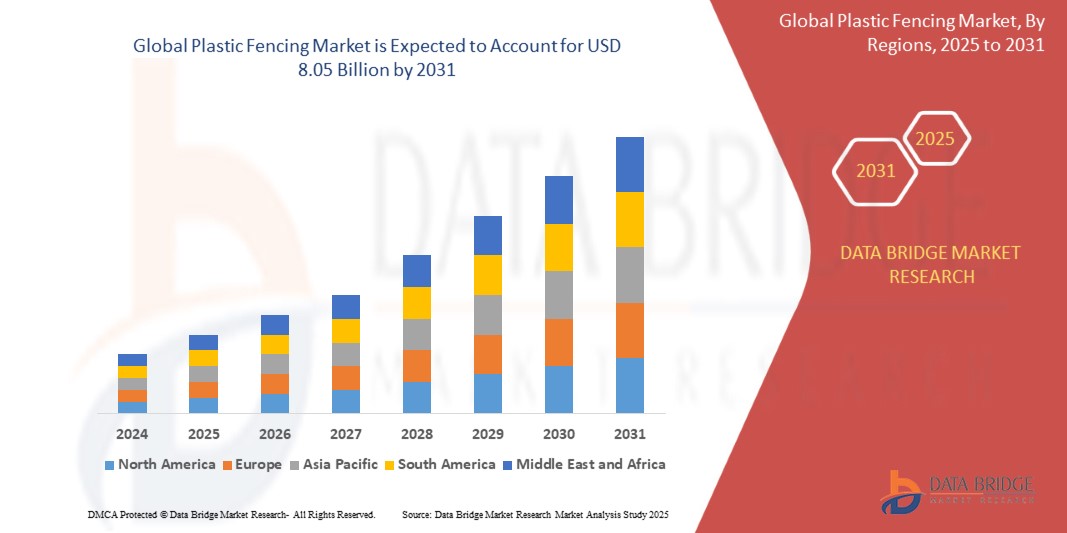世界のプラスチックフェンス市場の規模、シェア、トレンド分析レポート
Market Size in USD Billion
CAGR :
% 
| 2024 –2031 | |
| USD 5.29 Billion | |
| USD 8.05 Billion | |
|
|
|
>世界のプラスチックフェンス市場のセグメンテーション、材質別(プラスチックフェンス、ポリエチレン/ HDPE、ビニール)、製品別(ゲート、ピケットフェンス、メッシュ/チェーンリンクフェンス、ポスト&レールフェンス)、用途別(一時的、プライバシー、境界、プール)、エンドユーザー別(農業、住宅、商業および産業) - 2031年までの業界動向と予測
世界のプラスチックフェンス市場分析
世界のプラスチックフェンス市場は、耐久性があり、メンテナンスが少なく、費用対効果の高いフェンスソリューションに対する需要の増加などの要因に牽引され、着実に成長しています。ビニール、ポリエチレン、リサイクルプラスチックなどの材料で作られたプラスチックフェンスは、耐候性、耐腐食性、害虫耐性などの利点があり、住宅、商業、農業用途で人気があります。市場はまた、環境に優しい製品のトレンドの高まりからも恩恵を受けており、リサイクルプラスチックフェンスが勢いを増しています。北米は採用率の高さから市場をリードしており、都市化とインフラ開発が需要を牽引しているヨーロッパとアジア太平洋がそれに続きます。製造技術の進歩と持続可能性への注目の高まりにより、市場はさらに成長すると予想されています。
プラスチックフェンス市場規模
世界のプラスチックフェンス市場規模は、2023年に52億9,000万米ドルと評価され、2024年から2031年の予測期間中に5.40%のCAGRで成長し、2031年には80億5,000万米ドルに達すると予測されています。市場価値、成長率、セグメンテーション、地理的範囲、主要プレーヤーなどの市場シナリオに関する洞察に加えて、Data Bridge Market Researchがまとめた市場レポートには、輸出入分析、生産能力概要、生産消費分析、価格動向分析、気候変動シナリオ、サプライチェーン分析、バリューチェーン分析、原材料/消耗品概要、ベンダー選択基準、PESTLE分析、ポーター分析、規制枠組みも含まれています。
プラスチックフェンス市場の動向
「耐久性があり、メンテナンスが少なく、コスト効率の高いフェンスソリューションの需要が高まっています」
世界のプラスチックフェンス市場は、耐久性があり、メンテナンスが少なく、費用対効果の高いフェンスソリューションに対する需要の高まりに牽引され、大幅な成長を遂げています。主な傾向としては、木材や金属などの従来の素材に比べて耐候性と耐久性に優れたビニールフェンスや複合フェンスが好まれる傾向が高まっています。持続可能性への取り組みも市場に影響を与えており、環境に優しいリサイクルプラスチックフェンスが注目を集めています。さらに、住宅建設や商業建設の増加、都市化やインフラ整備も需要を後押ししています。カスタマイズ可能なデザインや色など、製造における技術の進歩も市場の拡大に寄与しています。北米とヨーロッパは主要な市場であり、新興地域への関心が高まっています。
レポートの範囲とプラスチックフェンス市場のセグメンテーション
|
属性 |
プラスチックフェンスの主要市場分析 |
|
セグメンテーション |
|
|
対象国 |
米国、カナダ、メキシコ、ドイツ、フランス、英国、オランダ、スイス、ベルギー、ロシア、イタリア、スペイン、トルコ、その他のヨーロッパ諸国、中国、日本、インド、韓国、シンガポール、マレーシア、オーストラリア、タイ、インドネシア、フィリピン、その他のアジア太平洋諸国、サウジアラビア、UAE、南アフリカ、エジプト、イスラエル、その他の中東およびアフリカ諸国、ブラジル、アルゼンチン、その他の南米諸国 |
|
主要な市場プレーヤー |
Barrette Outdoor Living(米国)、CertainTeed(米国)、Durafence(米国)、伊藤忠商事(日本)、Pexco(米国)、Planet Polynet(インド)、Seven Trust(中国)、Superior Plastic Products(米国)、Tenax(イタリア)、Veka AG(ドイツ) |
|
市場機会 |
|
|
付加価値データ情報セット |
Data Bridge Market Research がまとめた市場レポートには、市場価値、成長率、セグメンテーション、地理的範囲、主要プレーヤーなどの市場シナリオに関する洞察に加えて、輸出入分析、生産能力の概要、生産消費分析、価格動向分析、気候変動シナリオ、サプライ チェーン分析、バリュー チェーン分析、原材料/消耗品の概要、ベンダー選択基準、PESTLE 分析、ポーター分析、規制枠組みも含まれています。 |
プラスチックフェンス市場の定義
プラスチックフェンスは、ビニール (PVC)、ポリエチレン、ポリプロピレンなどの合成材料で作られたバリアまたは囲いの一種です。耐久性があり、メンテナンスが少なく、耐候性があるため、住宅、商業、農業用途で広く使用されています。木材や金属などの従来のフェンス材料とは異なり、プラスチックフェンスは腐ったり、錆びたり、腐食したりしないため、屋外環境に最適です。
プラスチックフェンス市場の動向
ドライバー
- 持続可能性のトレンド
消費者が環境問題に対する意識が高まるにつれ、持続可能性のトレンドが世界のプラスチックフェンス市場の成長を大きく牽引しています。環境に優しい素材への移行は、カーボンフットプリントの削減と持続可能な慣行の促進への重点が高まっていることがきっかけとなっています。プラスチックフェンスは、特にリサイクル素材で作られている場合、森林破壊や資源枯渇を伴うことが多い木材や金属などの従来のフェンスオプションに代わる魅力的な選択肢を提供します。さらに、プラスチック製造の革新により、メンテナンスが最小限で済む耐久性があり長持ちするフェンスソリューションが開発され、持続可能な生活習慣にさらに適合しています。消費者はまた、材料をリサイクルして再利用して廃棄物を削減できる循環型経済に貢献する製品に惹かれています。建設や造園で持続可能な素材の使用を奨励する環境に配慮した建築基準や規制の増加も、プラスチックフェンスの採用を後押ししています。たとえば、ecospace のブログによると、複合フェンスは、従来の素材に代わる環境に優しい代替品を提供することで、持続可能性のトレンドを体現しています。リサイクルプラスチックと木材繊維で作られているため、炭素排出量と森林破壊を削減しながら、耐久性とメンテナンスの手間がかかりません。これは持続可能な製品に対する消費者の好みと一致しており、プラスチックフェンス市場の成長を促進しています。
- 都市化とインフラ整備の進展
都市化とインフラ開発は、世界のプラスチックフェンス市場の大きな原動力です。都市部の人口が増加し続けるにつれて、住宅、商業スペース、公共インフラの需要が高まり、新しい住宅街、商業施設、公園、レクリエーション施設の建設につながっています。この成長には効果的な境界ソリューションが必要であり、プラスチックフェンスは耐久性、メンテナンスの容易さ、美観の多様性から人気のある選択肢となっています。さらに、道路、公共交通機関、緑地などの都市インフラの改善を目指す政府の取り組みにより、フェンス製品の需要がさらに高まっています。プラスチックフェンスは軽量で設置が簡単で、建設スケジュールを短縮できるため、都市開発業者や建設業者にとって特に魅力的です。さらに、都市が持続可能性を優先するにつれて、プラスチックフェンスのリサイクル可能な特性は、現代の環境に優しい建設慣行とよく一致しています。
機会
- 技術革新
技術革新は世界のプラスチックフェンス市場に大きなチャンスをもたらし、製品の性能と魅力を高める材料と製造プロセスの進歩を促進しています。ポリマー化学の革新により、木材や金属などの伝統的な材料の美観を模倣した高品質で耐久性のあるプラスチックが開発され、消費者の受け入れが向上しました。これらの進歩には、紫外線耐性、色の保持、全体的な強度の向上が含まれ、プラスチックフェンスは寿命と機能の点でより競争力があります。さらに、押し出し成形や射出成形などの高度な製造技術の導入により、より効率的な生産プロセスが可能になり、コストが削減され、製品の一貫性が向上します。メーカーは、統合照明やセンサーなど、プラスチックフェンスシステムの機能を強化できるスマートテクノロジーも模索しています。たとえば、2024年8月のHosungのブログによると、プラスチックフェンスパネルの技術革新により、紫外線保護や耐候性などの進歩により、耐久性と美観が向上しました。たとえば、Hosung Deck のような企業は、高度な製造技術を利用して、天然木の外観を模倣しながら優れた耐久性を備えた木材プラスチック複合材 (WPC) パネルを生産しています。さらに、生産におけるリサイクル素材や環境に優しい素材の増加は、持続可能性のトレンドと一致しており、環境意識の高い消費者にアピールしています。
- 新興市場への進出
新興市場の拡大は、特にアジア太平洋、ラテンアメリカ、アフリカなどの地域で、世界のプラスチックフェンス市場にとって大きなチャンスをもたらします。これらの地域では、急速な都市化、工業化、インフラ開発が見られ、耐久性があり手頃な価格のフェンスソリューションの需要が高まっています。これらの地域では、可処分所得の増加と中流階級人口の増加も住宅や商業施設への支出の増加に寄与しており、プラスチックフェンスの需要をさらに高めています。さらに、新興市場の政府は、高速道路、公共公園、住宅開発などの大規模なインフラプロジェクトへの投資を増やしており、メンテナンスが少なく、寿命が長く、費用対効果が高いため、プラスチックフェンスは理想的な選択肢です。持続可能で環境に優しい製品への移行も、リサイクル可能で耐久性のあるプラスチックフェンス材料の需要と一致しています。市場の飽和度が低く、建設活動が増加している新興経済は、メーカーが存在感を拡大し、今後数年間で大きな市場シェアを獲得するための肥沃な土壌を提供します。
制約/課題
- 初期費用が高い
世界のプラスチックフェンス市場における主な制約の 1 つは、木材や金属などの従来のフェンス材料と比較して、これらの製品に関連する初期コストが高いことです。プラスチックフェンスは耐久性があり、メンテナンスの必要性が低いため、長期的には大幅な節約になりますが、初期投資は多くの消費者にとって、特に価格に敏感な市場では、妨げになる可能性があります。この初期費用は、長期的なメリットよりも目先のコスト削減を優先する可能性のある、予算を重視する住宅所有者や小規模建築業者の間での市場浸透を制限する可能性があります。さらに、プラスチックフェンスは高級品であるという認識がこの課題をさらに悪化させる可能性があります。潜在的な購入者は、市場で入手可能なより安価な代替品と比較することが多いためです。
- 代替材料との競争
世界のプラスチックフェンス市場は、木材、金属、複合材などの代替素材との競争により、大きな制約に直面しています。伝統的な木製フェンスは、その自然な美しさと本物らしさから好まれることが多く、クラシックな外観を求める住宅所有者にアピールできます。プラスチックフェンスは耐久性がありメンテナンスの手間が少ないですが、特に高級住宅開発では、木材の見た目の魅力や金属フェンスの頑丈さを優先する消費者もいます。さらに、木質繊維と再生プラスチックを組み合わせた複合材は、木材の外観を模倣しながらも、耐久性と環境要因に対する耐性を高めるという中間的な立場を提供します。これは、美観や寿命を懸念してプラスチックフェンスの採用をためらっている顧客を引き付けることができます。さらに、代替フェンスの原材料価格の変動により、競争力が高まり、プラスチックフェンスの市場シェアに影響を与える可能性があります。
この市場レポートでは、最近の新しい開発、貿易規制、輸出入分析、生産分析、バリュー チェーンの最適化、市場シェア、国内および現地の市場プレーヤーの影響、新たな収益源の観点から見た機会の分析、市場規制の変更、戦略的市場成長分析、市場規模、カテゴリ市場の成長、アプリケーションのニッチと優位性、製品の承認、製品の発売、地理的拡大、市場における技術革新などの詳細が提供されます。市場に関する詳細情報を取得するには、アナリスト ブリーフについて Data Bridge Market Research にお問い合わせください。当社のチームが、情報に基づいた市場決定を行い、市場の成長を実現できるようお手伝いします。
原材料不足と出荷遅延の影響と現在の市場シナリオ
Data Bridge Market Research は、市場の高水準な分析を提供し、原材料不足や出荷遅延の影響と現在の市場環境を考慮した情報を提供します。これは、戦略的な可能性を評価し、効果的な行動計画を作成し、企業が重要な決定を下すのを支援することにつながります。
標準レポートの他に、予測される出荷遅延からの調達レベルの詳細な分析、地域別の販売代理店マッピング、商品分析、生産分析、価格マッピングの傾向、調達、カテゴリパフォーマンス分析、サプライチェーンリスク管理ソリューション、高度なベンチマーク、その他の調達および戦略サポートのサービスも提供しています。
経済減速が製品の価格と入手可能性に及ぼす予想される影響
経済活動が減速すると、業界は打撃を受け始めます。DBMR が提供する市場洞察レポートとインテリジェンス サービスでは、景気後退が製品の価格設定と入手しやすさに及ぼす予測される影響が考慮されています。これにより、当社のクライアントは通常、競合他社より一歩先を行き、売上と収益を予測し、損益支出を見積もることができます。
世界のプラスチックフェンス市場の範囲
市場は、材料、製品、アプリケーション、エンドユーザーに基づいてセグメント化されています。これらのセグメントの成長は、業界のわずかな成長セグメントを分析するのに役立ち、ユーザーに貴重な市場の概要と市場の洞察を提供し、コア市場アプリケーションを特定するための戦略的決定を下すのに役立ちます。
材料
- プラスチックフェンス
- ポリエチレン/HDPE
- ビニール
製品
- ゲイツ
- ピケットフェンス
- メッシュ/金網フェンス
- ポスト&レールフェンス
応用
- 一時的
- プライバシー
- 境界
- プール
エンドユーザー
- 農業
- 居住の
- 商業・工業
世界のプラスチックフェンス市場の地域分析
市場は分析され、市場規模の洞察と傾向は、上記のように国、材料、製品、アプリケーション、およびエンドユーザー別に提供されます。
市場に含まれる国は、米国、カナダ、メキシコ、ドイツ、フランス、英国、オランダ、スイス、ベルギー、ロシア、イタリア、スペイン、トルコ、その他のヨーロッパ諸国、中国、日本、インド、韓国、シンガポール、マレーシア、オーストラリア、タイ、インドネシア、フィリピン、その他のアジア太平洋諸国、サウジアラビア、UAE、南アフリカ、エジプト、イスラエル、その他の中東およびアフリカ諸国、ブラジル、アルゼンチン、その他の南米諸国です。
北米は、住宅、商業、農業用途の需要の高さと、耐久性がありメンテナンスの手間が少ないフェンスソリューションの普及により、プラスチックフェンス市場を独占すると予想されています。
アジア太平洋地域は、急速な都市化、インフラ開発、住宅および商業部門における耐久性がありメンテナンスの手間が少ないフェンス ソリューションの需要増加により、プラスチック フェンスの市場が最も急速に成長しています。
レポートの国別セクションでは、市場の現在および将来の傾向に影響を与える国内市場における個別の市場影響要因と規制の変更も提供しています。下流および上流のバリュー チェーン分析、技術動向、ポーターの 5 つの力の分析、ケース スタディなどのデータ ポイントは、個々の国の市場シナリオを予測するために使用される指標の一部です。また、国別データの予測分析を提供する際には、グローバル ブランドの存在と可用性、および地元および国内ブランドとの競争が激しいか少ないために直面する課題、国内関税と貿易ルートの影響も考慮されます。
世界のプラスチックフェンス市場シェア
市場競争環境では、競合他社の詳細が提供されます。含まれる詳細には、会社概要、会社の財務状況、収益、市場の可能性、研究開発への投資、新しい市場への取り組み、世界的なプレゼンス、生産拠点と施設、生産能力、会社の強みと弱み、製品の発売、製品の幅と広さ、アプリケーションの優位性などがあります。提供される上記のデータ ポイントは、市場に関連する会社の焦点にのみ関連しています。
プラスチックフェンス市場で活動するマーケットリーダーは次のとおりです。
- バレッテ アウトドア リビング (米国)
- CertainTeed(米国)
- デュラフェンス(米国)
- 伊藤忠商事株式会社(日本)
- ペクスコ(米国)
- プラネットポリネット(インド)
- セブントラスト(中国)
- スーペリアプラスチックプロダクツ(米国)
- テナックス(イタリア)
- ヴェカAG(ドイツ)
プラスチックフェンス市場の最新動向
- バレッテ・アウトドア・リビングによると、同社は2024年2月に新しい囲い製品ラインを立ち上げ、一部のRDI手すりのアップデートを発表した。これらの開発は、屋外生活ソリューションを強化することを目的としており、フェンスと手すり市場における同社の革新と品質への取り組みを示すものである。
- Superior Outdoor Productsによると、同社は2024年2月に、大量生産業者向けに、素早い設置と低メンテナンスを実現するよう設計された100シリーズの手すりを発売した。100シリーズは、白で四角い手すり子付きで、圧力処理された手すりに代わる競争力のある選択肢を提供し、シンプルさと手頃な価格を求める顧客の要求に応えると同時に、高品質のアメリカ製ビニール製品への同社の取り組みを示す。
SKU-
世界初のマーケットインテリジェンスクラウドに関するレポートにオンラインでアクセスする
- インタラクティブなデータ分析ダッシュボード
- 成長の可能性が高い機会のための企業分析ダッシュボード
- カスタマイズとクエリのためのリサーチアナリストアクセス
- インタラクティブなダッシュボードによる競合分析
- 最新ニュース、更新情報、トレンド分析
- 包括的な競合追跡のためのベンチマーク分析のパワーを活用
調査方法
データ収集と基準年分析は、大規模なサンプル サイズのデータ収集モジュールを使用して行われます。この段階では、さまざまなソースと戦略を通じて市場情報または関連データを取得します。過去に取得したすべてのデータを事前に調査および計画することも含まれます。また、さまざまな情報ソース間で見られる情報の不一致の調査も含まれます。市場データは、市場統計モデルと一貫性モデルを使用して分析および推定されます。また、市場シェア分析と主要トレンド分析は、市場レポートの主要な成功要因です。詳細については、アナリストへの電話をリクエストするか、お問い合わせをドロップダウンしてください。
DBMR 調査チームが使用する主要な調査方法は、データ マイニング、データ変数が市場に与える影響の分析、および一次 (業界の専門家) 検証を含むデータ三角測量です。データ モデルには、ベンダー ポジショニング グリッド、市場タイムライン分析、市場概要とガイド、企業ポジショニング グリッド、特許分析、価格分析、企業市場シェア分析、測定基準、グローバルと地域、ベンダー シェア分析が含まれます。調査方法について詳しくは、お問い合わせフォームから当社の業界専門家にご相談ください。
カスタマイズ可能
Data Bridge Market Research は、高度な形成的調査のリーダーです。当社は、既存および新規のお客様に、お客様の目標に合致し、それに適したデータと分析を提供することに誇りを持っています。レポートは、対象ブランドの価格動向分析、追加国の市場理解 (国のリストをお問い合わせください)、臨床試験結果データ、文献レビュー、リファービッシュ市場および製品ベース分析を含めるようにカスタマイズできます。対象競合他社の市場分析は、技術ベースの分析から市場ポートフォリオ戦略まで分析できます。必要な競合他社のデータを、必要な形式とデータ スタイルでいくつでも追加できます。当社のアナリスト チームは、粗い生の Excel ファイル ピボット テーブル (ファクト ブック) でデータを提供したり、レポートで利用可能なデータ セットからプレゼンテーションを作成するお手伝いをしたりすることもできます。





